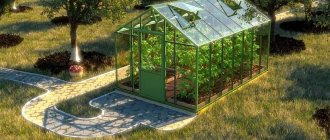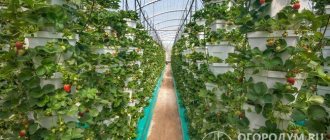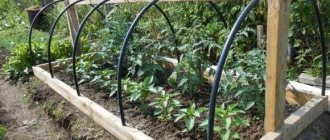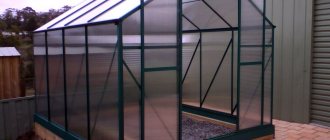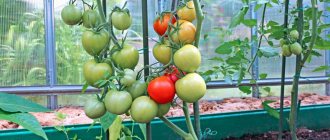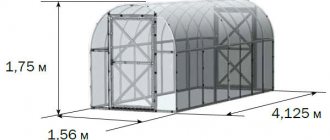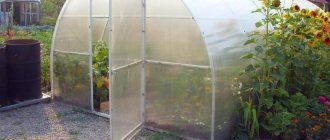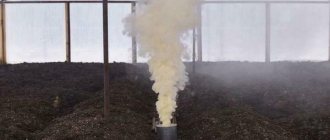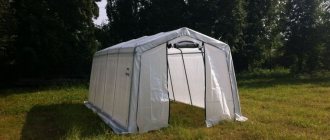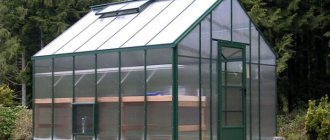Selecting and installing a greenhouse is not an easy task. For its successful location on the site, you need to clarify important points for yourself. The most important thing is that the greenhouse should be well illuminated by sunlight and be freely accessible.
When building a greenhouse on a small summer cottage, you need not only to decide in advance on its size and wisely select the materials from which it will be made, but also to carefully select the location of the future “dislocation” of the greenhouse. The yield of the crops grown, the strength of the structure itself and the efficiency of its “work” will directly depend on its correct location on the site. So, you have decided to get a greenhouse. How to proceed?
We analyze the landscape features of the site
The following factors need to be considered during installation:
- Soil quality. Taking it into account is necessary due to the fact that a greenhouse installed on too soft soil may sag or tilt significantly over time. As a result, the strength of the structure will suffer and the doors may stop closing. Misalignment can even lead to destruction of the coating or damage to the frame. In this regard, you should choose a place where the soil is more dense.
If the choice fell on a swampy area, then it is necessary to make good drainage before installing the structure. When placing the greenhouse on soft soil, it is necessary to make a foundation.To determine the composition of the soil in the area, dig a hole and check what is under the fertile layer. If there is clay there, then it is not recommended to install a greenhouse in this place. Clay will retain water when watering, this will cause stagnation of water and increased humidity inside. This phenomenon is unfavorable for plants. Try to find a place where sand is located under the fertile layer.
If all the soil on your site is located on a clay layer, before installing the greenhouse you need to dig a pit, replace the clay layer with a sand cushion, place a drainage layer under it and then fill it with a fertile layer. Only after this can a greenhouse be installed in this place.
It is also important to ensure that there is no groundwater close to the surface on the site. The distance to them should be at least one and a half meters.
- Presence of slope. You should not place the greenhouse on a sloped area.
Choose a flat area for it. The ideal location is to install on a level area with firm ground. Both longitudinal and transverse inclination of the structure should not be allowed. If your entire site is on a slope, you can soften it by building a foundation under the building.
general information
Before you start building a greenhouse, you need to determine its place on the site. This problem should be solved taking into account several prerequisites. If the structure is placed incorrectly, the following troubles may arise:
- unsuitable microclimate inside the greenhouse;
- crop shortage;
- the appearance of condensation;
- unsuitable temperature for plant growth.
Finding the optimal location on the site for the greenhouse is an important step, since the structure should be placed in such a way that the sun's rays freely fall on it. In addition, wind load must be taken into account.
Orientation of the greenhouse according to the cardinal directions
The illumination of the plants grown in it depends on how the greenhouse is located relative to the cardinal directions. If this criterion is chosen incorrectly, the plants will experience a lack of illumination, which means that the size of the resulting harvest will sharply decrease.
Of course, you can compensate for the lack of sunlight by using artificial lighting, but this will immediately lead to an increase in energy costs. Therefore, it is more advisable to calculate the location in such a way as to make maximum use of free solar energy.
How to correctly position the greenhouse on the site according to the cardinal directions? Is it better from north to south or from west to east? It is advisable to place the greenhouse in a place that receives sunlight all day long. It is more advisable to choose a west-east direction. With this arrangement, the plants will be illuminated as much as possible from morning to evening. And if the greenhouse is operated in winter, the costs of lighting and heating can be reduced.
IMPORTANT: If you have two greenhouses nearby, make sure that they do not block the sun from each other.
If it is impossible to install the structure in a place with maximum light throughout the day, try to place it in such a way that the plants receive light in the first half of the day. The most dangerous time for plants is dawn, so if the sun does not warm them in the morning, growth may slow down and the ovaries may fall off.
Lighting the greenhouse in the afternoon is the worst option. The sun will not have time to warm up the interior space, and the plants will freeze overnight. Exposure to sunlight on chilled plants that have not had time to warm up after lunch will cause burns.
ATTENTION: Do not install the greenhouse near or directly under tall trees. They will shade the plants.
Start
Never try to do everything at once. Don’t be afraid to start small - a successful start will give you confidence in your abilities and increase motivation for further work.
In the first year of gardening, we recommend planting radishes, cucumbers, onions, and sowing lettuce seeds. It seems like a simple set, but it’s quite enough for preparing salads, and it won’t take a lot of time and effort to work in the garden.
Advice! Don't try to grow tomatoes and strawberries the first year! These are capricious crops that require careful care and certain skills.
Which way is the wind blowing?
Wind direction is another important factor that should be taken into account during installation. The structure must be reliably protected from gusts of wind. If the greenhouse is in a draft, the temperature inside it will be too low for growing heat-loving crops.
How to install a greenhouse? Even in a small area, choose the quietest place. Try to position the greenhouse so that it is protected as much as possible from gusts of wind by other buildings. Protecting the building from the north wind is especially important.
IMPORTANT: When protecting the greenhouse from the wind with the help of other buildings, make sure that they do not simultaneously block access to light.
Alternatively, you can use planting a hedge or installing a blind fence as a barrier from the winds. In this case, it is important to correctly calculate the height of the fence and its distance from the greenhouse. The bushes should be planted at a distance of 20 meters, and the fence with a greenhouse height of 2 meters should be at least 7 meters.
REFERENCE: If it is not possible to protect the building from the wind, install it so that the main flows fall on the front part. This will help avoid heat loss.
SNiP standards
These buildings can be classified as household buildings with an undetectable degree of fire hazard and as small architectural structures.
Many structures made of polycarbonate and covered with film correspond to the category of temporary buildings that do not have a permanent foundation. In this case, they should be placed at a distance of 1 meter from the fence.
According to the standards of SNiP 2.07.01-89 set of rules SP 42.13330.2011 “Urban planning. Planning and development of urban and rural settlements", greenhouses are classified as outbuildings and are located at a distance:
- 1 m from the fence;
- 3 m to a residential building;
- 1 m to outbuildings and poultry houses.
Standards for the location of buildings on the site In accordance with the requirements of SanPiN 21.01 - 97, the distance from the greenhouse to the communication line and road is regulated. Construction rules regarding distance from the red line apply to all types of buildings. There is only one standard - at least 5 meters. From the road - 5 m, border with the lane - 3 m.
In 2005, for buildings such as greenhouses, SNiP requirements were transferred from legislative initiatives to recommended ones. Now there is no criminal liability for violating the rules, standards and norms of individual construction.
Penalties: fine and, by court decision, demolition of non-residential buildings.
Taking into account the distance to communications
The mistake of many gardeners is the decision to build a greenhouse in the far corner of the plot for aesthetic reasons. To prevent the building from spoiling the appearance of the site, they try to locate it as far as possible from the house. Beauty in this case turns into additional inconvenience and unnecessary material costs.
The greenhouse needs water, and sometimes gas and electricity. So you have to pull pipes or wires across the entire area. Therefore, when choosing a location, take into account the need to lay utility systems. Also think about the ease of maintenance of the greenhouse. It should be easy to drive up and approach.
Monastery courtyard
Proponents of minimalism choose simple, clear geometric shapes to decorate their garden. For such people, a rectangular garden layout is perfect.
Straight lines combine beautifully with geometric shapes, and cobblestone paths not only attract the eye with their simple beauty, but also provide convenient access to the beds.
Note!
Trellis for grapes? do it yourself - ready-made solutions for the garden plot. Instructions + 120 photos of options for the correct trellis
The best ideas for a summer cottage: 110 photos of exclusive ideas and new products in landscape design at a summer cottage
House for a well: a step-by-step master class on how to make it yourself, recommendations from craftsmen with simple work patterns
Another advantage of the ascetic design is that there is room for a small pond, miniature benches and low-growing bushes.
How to build a greenhouse on the roof of a house?
The idea of constructing greenhouses on buildings is not new in modern conditions. In Europe, this practice has long been rooted and has become in demand. In Russia, there is not yet such a massive deployment of greenhouses on various buildings. Moreover, this option is quite interesting both in terms of saving space and creating the most favorable conditions for growing plants.
Judge for yourself, a greenhouse on the roof is the maximum amount of solar energy and means more heat for plants. Combined with saving space for growing vegetables in small areas, this solution has only positive aspects from all sides. Moreover, a greenhouse can be built not only in a private building, but also on the roof of an apartment building.
Of course, a building located on the roof has its own special requirements for both the design and the technology for growing vegetables in it. Without touching on the second question, which requires a separate article, let's talk about the features of the location of the greenhouse on the roof.
The design should be as light as possible and at the same time quite durable. The coating should not be glass, but polycarbonate. This is due to the fact that there are very strong gusts of wind on the roof of the high-rise building. The material must be shock resistant. It is unacceptable to build a structure on the roof covered with plastic film - it will be carried away or torn apart by the first strong wind. The frame must also be strong.
The most suitable for the roof is an arched shape, which helps reduce snow and wind loads.
There are several options for the location of the greenhouse:
- Construction of an additional transparent bay window.
- Installing a finished greenhouse directly onto an existing roof.
- Rebuilding the roof by setting up a kind of floor on it with transparent walls (that is, converting the attic).
IMPORTANT: Before deciding to install a structure, carefully study the documents for the house and calculate the load-bearing capacity of the floors to avoid problems. When calculating, do not forget to include the weight of the soil in the mass.
Another important point is preparation for installing the roof covering. It needs to be provided with additional waterproofing. When installing, also do not forget to provide a water supply system, since carrying water in buckets to a height will be problematic. The most beneficial in this case is drip irrigation.
To ensure air access to the plants, you need to provide the maximum number of vents, since on hot days the temperature on the roof may be too high, and your plants will simply burn from overheating.
REFERENCE: You can connect the greenhouse to the ventilation of the house. In this case, oxygen from the plants will enter the living space, which is undoubtedly a plus.
A greenhouse on the roof of an apartment building is an excellent option for gardening for residents who do not have suburban dacha plots.
Compliance with all the rules for the location of greenhouses on summer cottages, vegetable gardens and roofs of houses, as well as taking into account all the listed nuances will allow you to get the maximum harvest in your building.
Heat preservation
Even if the structure is installed correctly, it is still impossible to completely secure the structure. Winter air can ruin plants, especially if they are in a greenhouse that is located on the ground without a foundation.
Gardeners protect the building from the negative influence of cold street air using the following techniques:
- the structure is erected on a 60-centimeter plinth made of gas, foam or expanded clay concrete. Using this method, heat exchange between the soil inside and outside the building will be eliminated.
- To retain heat, the beds are raised from the ground by 50 cm.
- If the greenhouse is made of glass, then double glazing must be used, and the material must be joined with waterproof glue.
Only heating devices will save plants from severe cold, but the mentioned tricks will also help keep the heat indoors.
Photo
In the following photographs you can see the options for placing greenhouses on a garden plot
Location of the greenhouse on the site and orientation diagram according to the cardinal directions:
French charm
Would you like to have something similar to the design of the royal Versailles from the time of the Sun King? Then you’ll have to start arranging your site in the French style!
It should be remembered that you will have to determine the central part of the composition, from which triangular beds will extend, forming a hemisphere or semicircle. Symmetry must be observed when designing each element.
More detailed information on how to plan an exquisite vegetable garden can be easily found on the Internet. We will list those elements that will decorate a suburban area in general, and a vegetable garden in particular:
- decorative borders of paved paths;
- miniature fountain;
- curly (topiary) bush trimming;
- garden sculptures.
Important! Low-growing shrubs are suitable for such a garden. They should not “obstruct” the view, and from time to time they “demand” a fashionable “hairstyle”.
Note!
- Do-it-yourself canopy over the porch - choice of materials, types of structures + instructions for making it yourself
Do-it-yourself bathhouse in the country: expert recommendations, choice of materials, step-by-step description + instructions for DIY construction
How to sew outdoor curtains for a gazebo with your own hands: step-by-step instructions + 140 photos of ready-made ideas
Pros and cons of polycarbonate
It’s not for nothing that polycarbonate has taken a leading position in country house construction! Indeed, it has many advantages:
- Fire resistance. The material does not support combustion, but only smolders. Areas affected by fire quickly die out.
- Impact resistance. This figure is about 20 times more than glass! Polycarbonate is not afraid of any hail, whereas glass can break.
- Flexibility. Only greenhouses with a pointed roof could be built from glass; this increased the consumption of material. Polycarbonate bends so that you can cover the roof in a semicircle.
- Excellent thermal insulation properties. The fact is that the polycarbonate sheet has cells filled with air. Air is the world's worst conductor of energy. Due to this, the temperature inside the building is maintained much better than in a glass greenhouse.
- The greenhouse does not need to be dismantled for the winter. Thanks to its strength and heat resistance, polycarbonate can withstand the harsh Russian winter with frost and snowdrifts.
- A polycarbonate greenhouse can last up to 10 years.
But this material is not perfect. Even polycarbonate has disadvantages:
- Low abrasive resistance. Polycarbonate is resistant to scratches and damage.
- Afraid of ultraviolet radiation.
- Changes under the influence of temperature. That is, in warm weather the material expands, in cold weather it contracts. This property must be taken into account during installation, that is, leave a gap for expansion.
- Polycarbonate is expensive. This point is controversial. Yes, for a square meter of this material you will have to pay about 400 rubles, while for glass it is 300-350. But if you take into account labor costs, time costs and all the other disadvantages of glass, then polycarbonate will be more profitable.
- Forced ventilation is required.
- The material has low light transmittance.
Despite all the disadvantages, a greenhouse made of polycarbonate is more practical and better than one made of glass. Yes, and it will cost less.
Neighbor Compatibility
It is not only individual people who cannot find a common language among themselves and accumulate grievances against each other. It must be taken into account that the same thing happens among vegetables! You should adhere to certain rules in order to correctly plan the planting of vegetable crops in the beds and not cause hostility between garden partners. So, next door you can place:
- beans that will repel beetles from eggplants and fleas from cabbage;
- peas get along well with carrots and turnips;
- onions “make friends” with lettuce, cucumber, carrots and Brussels sprouts;
- cucumbers have nothing against being next to white cabbage, corn, dill and garlic;
- parsley will give a good harvest in the company of basil, onions, cucumbers, beans, asparagus and tomatoes.
This is interesting! Most garden crops experience something like an allergy to one or another neighbor, but peppers, pumpkin, asparagus, lettuce, mustard, zucchini, leeks, squash, horseradish, have a very “flexible” character and do not have incompatible plants.
Rules for the location of beds
To get the maximum harvest, you need to properly arrange your garden at your dacha, and for this you must adhere to the following rules:
- choose the sunniest place - all vegetable crops love warmth and the rays of daylight;
- Before sowing or planting, the soil should be leveled;
- if the soil has a slope, then plants should be planted across it (slope), thereby increasing the efficiency of irrigation;
- try to keep the beds the same length (three to four meters) and width (up to 45 centimeters).
Important! Symmetry always improves visual perception and allows for free access to the cultivated area. Do not arrange beds between fruit trees under any circumstances - the shade will not allow you to get a good harvest, and besides, the chemicals that are used to treat the fruit trees may get into the vegetables!
